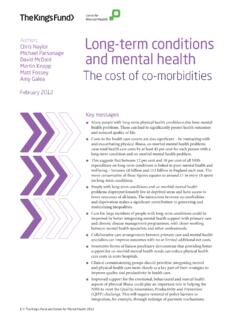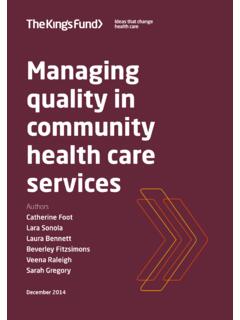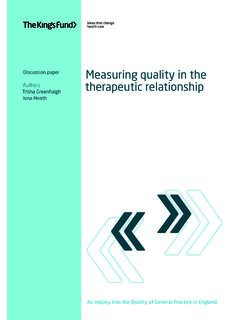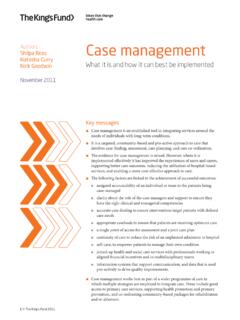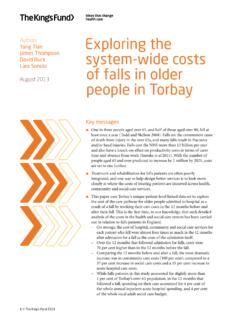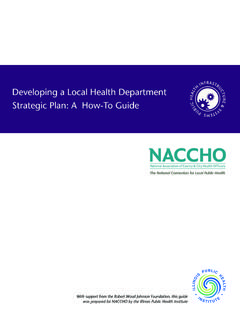Transcription of Leadership and Leadership Development in Health Care
1 Leadership and Leadership Development in Health care : The Evidence Base Contents Leadership and Leadership Development in Health care : 1. The Evidence Base Acknowledgements 1. Summary 2. Leadership for cultures of high quality care 5. Review structure 7. Leadership theory and research 7. Leadership theory and research in Health care 10. Leadership , culture and climate in Health care 14. Leader and Leadership Development 17. Conclusions 23. References 24. Appendix: Review methods 31. Leadership and Leadership Development in Health care : The Evidence Base Professor Michael West The King's Fund and Lancaster University Management School Kirsten Armit, Dr Lola Loewenthal Faculty of Medical Leadership and Management, London Dr Regina Eckert The Center for Creative Leadership , Belgium Thomas West Aston Business School, Aston University Allan Lee Manchester Business School Acknowledgements The authors would like to thank the following people for their support and involvement in this work: Deena Maggs, Beatrice Brooke and Kirsty Morrison (The King's Fund).
2 Anna Topakas (University of Sheffield). Wouter Keijser (TeamSHOPP Netherlands). Elise Anderson (Center for Creative Leadership ). Peter Lees (Faculty of Medical Leadership and Management). 1. Summary The key challenge facing all NHS organisations is to nurture cultures that ensure the delivery of continuously improving high quality, safe and compassionate healthcare. Leadership is the most influential factor in shaping organisational culture and so ensuring the necessary Leadership behaviours, strategies and qualities are developed is fundamental. What do we really know about Leadership of Health services? The Faculty of Medical Leadership and Management (FMLM), The King's Fund and the Center for Creative Leadership (CCL) share a commitment to evidence-based approaches to developing Leadership and collectively initiated a review of the evidence by a team including clinicians, managers, psychologists, practitioners and project managers.
3 This document summarises the evidence emerging from that review. The summary describes key messages from the review in relation to Leadership at different levels of analysis: it includes a description of the Leadership task and the most effective Leadership behaviours at individual, team, board and national levels. The Leadership task The Leadership task is to ensure direction, alignment and commitment within teams and organisations (Drath, McCauley, Palus, Van Velsor, O'Connor, McGuire, 2008). Direction ensures agreement and pride among people in relation to what the organisation is trying to achieve, consistent with vision, values and strategy.
4 Alignment refers to effective coordination and integration of the work. Commitment is manifested by everyone in the organisation taking responsibility and making it a personal priority to ensure the success of the organisation as a whole, rather than focusing only on their individual or immediate team's success in isolation. Individual Leadership in Health services Effective leaders in Health services emphasise continually that safe, high quality, compassionate care is the top priority. They ensure that the voice of patients is consistently heard at every level; patient experience, concerns, needs and feedback (positive and negative) are consistently attended to.
5 They offer supportive, available, empathic, fair, respectful, compassionate and empowering Leadership . They promote participation and involvement as their core Leadership strategy. They ensure the staff voice'. is encouraged, heard and acted on across the organisation and provide practical support for staff to innovate within safe boundaries. They ensure everyone is clear about what they are required to do and give helpful, positive feedback on performance, including appreciation. They insist on transparency in relation to errors, serious incidents, complaints and problems and they regard mistakes as opportunities for learning.
6 They act effectively to deal with poor performance and proactively address aggressive, inappropriate and unacceptable behaviours displayed by staff or patients/carers. They promote continuous Development of the knowledge, skills and abilities of staff in order to improve quality of patient care , safety, compassion and the patient experience. They consistently encourage, motivate and reward innovation and introduce new and improved ways of working. Team Leadership Team leaders create a strong sense of team identity by ensuring: the team has articulated a clear and inspiring vision of the team's work; there is clarity about the team's membership; team members agree five or six clear, challenging, measureable team objectives; there is strong commitment to collaborative cross-team and cross-boundary working.
7 2. Team leaders ensure: there is shared Leadership in teams and members are fully involved in appropriate decision making; responsibility for decisions is delegated to members appropriately; and there are constructive debates about how to provide and improve high quality patient care . They also ensure the team regularly takes time out from its work to review its performance and how it can be improved, and there is a team climate of positivity, characterised by optimism, team efficacy, mutual supportiveness and good humour. Leadership of organisations Board Leadership is most effective when boards enact the vision and values of their organisations through what they attend to, monitor, reprove or reward; when they listen to patient voices as the most important sources of feedback on organisational performance; and when they listen to staff voices to discover how they can best support and enable staff to provide high quality patient care .
8 Effective boards ensure a strategy is implemented for nurturing a positive culture; sense problems before they happen and improve organisational functioning; promote staff participation and proactivity; enable and encourage responsible innovation by staff; and engage external stakeholders effectively to develop cooperative relationships across boundaries. National level Leadership National level Leadership plays a major role in influencing the cultures of NHS organisations. Numerous reports have called for the various bodies that provide national Leadership to develop a single integrated approach, characterised by a consistency of vision, values, processes and demands.
9 The approach of national Leadership bodies is most effective when it is supportive, developmental, appreciative and sustained;. when Health service organisations are seen as partners in developing Health services; and when Health service organisations are supported and enabled to deliver ever improving high quality patient care . The cultures of these national organisations should be collective models of Leadership and compassion for the entire service. Leader and Leadership Development Overall, there is little robust evidence for the effectiveness of specific Leadership Development programmes. Undoubtedly some programmes work for some people some of the time, but evaluating their effectiveness empirically is challenging and demonstrating positive effects on patient outcomes is difficult.
10 The interventions are diverse, participants face different work challenges and those providing the programmes have varying experience, knowledge and skill. More evidence-based approaches to Leadership Development in Health care are needed to ensure a return on the huge investments made. Experience in Leadership is demonstrably valuable in enabling leaders to develop their skills especially when they have appropriate guidance and support. In comparison with the focus on leader Development , Leadership Development the Development of the capacity of groups and organisations for Leadership as a shared and collective process is far less well explored and researched.
